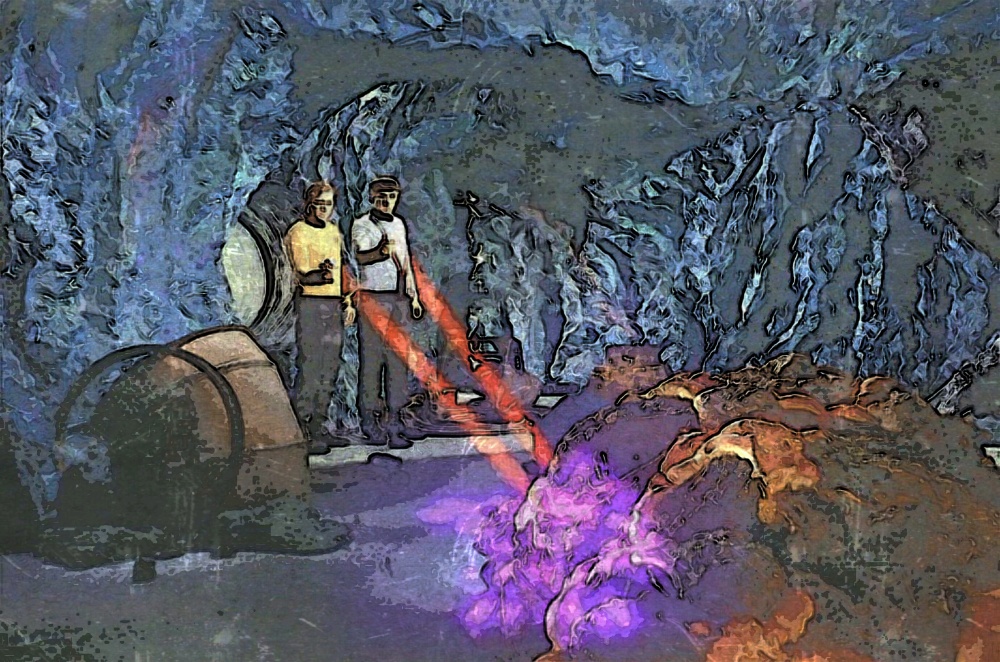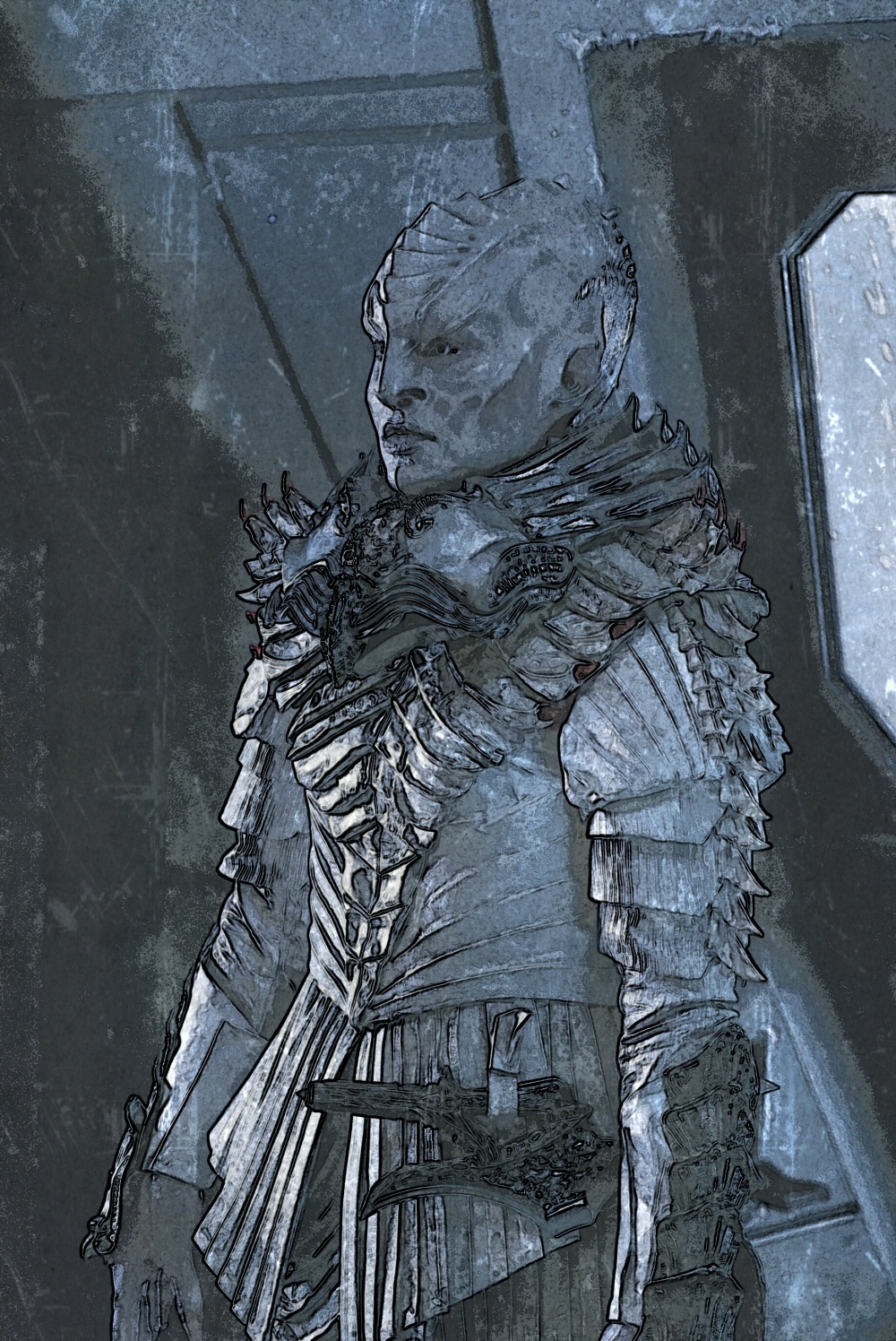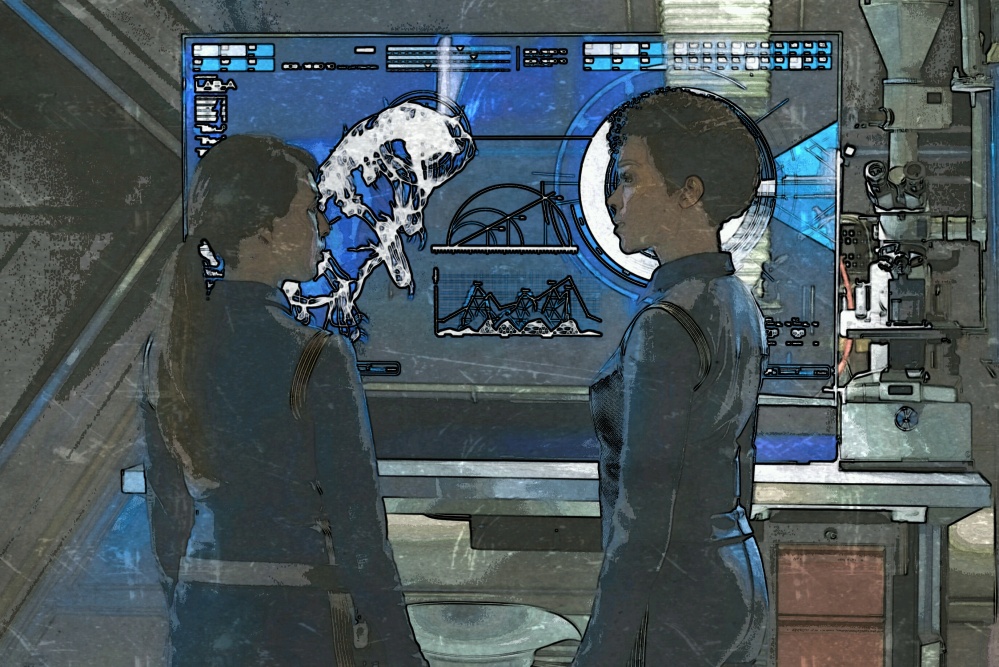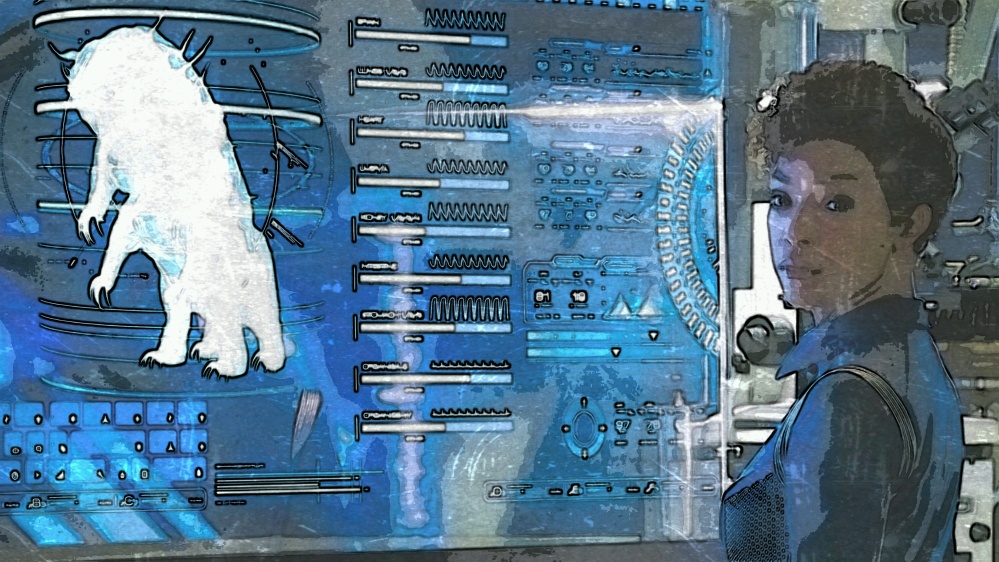*This post contains heavy spoilers for episode 4 of Star Trek: Discovery, and for the Original Series episode, “The Devil in the Dark”.
Star Trek: The Original Series – “The Devil in the Dark” (season 1, episode 26)
Written by Gene L. Coon; directed by Joseph Pevney; first aired in 1967
The Enterprise is called to the mining colony on Janus VI, where a mysterious creature has been melting miners. If the Federation wants to keep receiving shipments of their precious Unobtanium – sorry, Pergium – Kirk and company will have to rid the mine of its monster. But is it really a monster? Spock has his doubts. After some searching in the mining tunnels, and the unfortunate melting of a redshirt, Kirk ends up in an uneasy standoff with the alien, and Spock mind-melds with it, learning that it’s called a Horta … and that the miners should have been more careful with all those egg-shaped ‘rocks’ they found.
Star Trek: Discovery – “The Butcher’s Knife Cares Not for the Lamb’s Cry” (season 1, episode 4)
Written by Jesse Alexander & Aron Eli Coleite; directed by Olatunde Osunsanmi; first aired in 2017
Remember that monstrous creature that chased Burnham through an abandoned ship in the last episode? Well, Captain Lorca kept it, and he wants Burnham to find a way to weaponize it against the Klingons. She researches the creature under the supervision of Landry, who has nicknamed it “Ripper”, and whose aggressive approach proves, pretty conclusively, that Ripper responds badly to being threatened. But Burnham finds that Ripper is gentle, even friendly, when it isn’t in danger. She also discovers that it can communicate with the spores that fuel Discovery’s newfangled spore drive, allowing the ship to jump across vast distances. Which is good luck for a colony of miners under attack from the Klingons, who could really use reinforcements from the Discovery … but bad luck for Ripper, who is obviously in pain throughout the process, leaving Burnham with a dilemma.

The Horta (a.k.a. the giant pizza monster that melts people) might be one of the most iconic images Star Trek has ever produced. She makes a pretty good symbol, in fact, for the whole franchise and fandom, the good and the bad. At worst, she’s the go-to example for how silly and inaccessible Trek can seem to those who aren’t already invested in it (and how ridiculous Trek fans can end up sounding if we insist, to our dying breaths, that Trek is a serious thing that must be taken seriously). At best, though, she’s the go-to example of Trek’s honest intention to humanize the other – to promote empathy.

Discussions around Star Trek: Discovery, as its first season airs for the first time, often start with comparisons to older Trek, and its fourth episode, “The Butcher’s Knife Cares Not for the Lamb’s Cry”, was quickly compared by many to “The Devil in The Dark”, the Original Series episode in which we meet the Horta. The comparison is an obvious one, on the surface. “Devil” starts with a cold open that plays the not-yet-seen Horta as a horror movie monster, complete with a monster’s-eye-view close-up on that poor, screaming miner just before he’s killed; and by the time “Butcher” begins, we’re already familiar with its ‘monster’, Ripper, from the previous episode of Discovery, in which we saw it as an action movie monster, chasing our heroes through the corridors of an abandoned starship. Both Ripper and the Horta are treated as monsters based on these initial encounters; to be eliminated, in the Horta’s case, or to be turned to Starfleet’s advantage in their war efforts, in Ripper’s case. And both aliens manage some level of understanding with the one member of a Starfleet crew – Spock in “Devil”, Burnham in “Butcher” – who sees them as potentially more than a monster, based both on scientific interest and, perhaps, on that officer’s own status as something of an outsider, an ‘other’, in their own crew.

And in terms of visual design, both Ripper and the Horta are distinctly, well, alien-looking. Ripper is explicitly likened to a “macroscopic” tardigrade, while the Horta is described as silicon-based and rock-like; “I’m a doctor,” McCoy famously says, “not a bricklayer”. Where Discovery has the budget and current CGI technology to make Ripper a convincing, imposing presence, the Horta is the product of 1960s practical effects and a significantly lower budget, and, as mentioned above, is probably not going to win over any uninitiated viewers in 2017. But if we can look past that, we see that the design and movements of the Horta are deliberately tied to the themes of the episode. Given how famous the series has become for its many species of aliens almost indistinguishable from humans – aside from its Klingons, of course, who look like humans with beards – it’s actually pretty daring for TOS to focus a story about empathy around what is probably its most strikingly inhuman alien. Where other episodes would say to the audience, ‘look how similar these people are, look how ridiculous it is that they think they’re different from each other’ – “Let That Be Your Last Battleground”, I’m looking at you – “Devil” shows us beings who actually are very different from each other, and their efforts to come to an understanding are all the more interesting for it.

And while the Klingon subplot in “Butcher” is outside my focus here, I think it’s worth pointing out that Discovery may be trying something similar in its portrayal of the Empire. The new Klingon makeup and the extended scenes of subtitled Klingon dialogue, two particularly controversial aspects of Discovery, both have the effect of making the Klingons seem more genuinely ‘alien’. While this can be somewhat challenging to the audience, I do think it makes the conflict between humans and Klingons – like the conflict between the miners and the Horta – more meaningful … and any potential resolution to that conflict more satisfying.

Beyond the Klingon subplot – which will, I assume, play out gradually over the first season – does “Butcher” use its Ripper plot to make an argument for empathy with the other, as “Devil” does with the Horta? I think so. In the short time that Discovery has been on the air – around a month, as I’m writing this – it has taken criticism from some for a supposed failure to live up to Trek’s original vision. That vision, of course, has evolved over time more than some fans might like to admit; as we discussed last time, The Next Generation was already hinting at a need to critically examine it back in 1991, to say nothing of the microscope Deep Space 9 would put it under, shortly after. But, more than that, I think we sometimes forget that even TOS didn’t actually suggest that empathy and understanding and cooperation were necessarily the default modes for humanity in the 23rd century, or even just for Starfleet. “Devil” doesn’t argue for empathy by having its characters empathize with the Horta immediately – just the opposite. The episode shows us, first, the trouble a failure of empathy can lead to, and lets us watch as its characters’ view of the Horta slowly changes, until they finally take action to make the situation right.

In fact, it’s interesting that the Enterprise crew’s initial motivation for getting rid of the Horta is decidedly non-utopian. If all they needed to do was prevent her from killing any more miners, the solution would be obvious: evacuate the mine, get the miners to safety, and let them set up a new mining operation somewhere they probably won’t get melted. No, their problem is a surprisingly grounded one: the Federation needs the minerals from that mine, and can’t afford to abandon it, Horta or no Horta. Later incarnations of Trek, TNG in particular, would state directly that humanity had surpassed scarcity, poverty, even the need for currency, and while that’s a fascinating (and appealing) idea to explore, let’s be honest: I don’t think Trek ever really has explored it. We’ve never learned how humanity reached a post-scarcity state, or how a society like that actually functions, day to day – it’s just been treated as a given, as more of a plot device than a serious sci-fi concept. And we certainly don’t see a post-scarcity economy at work in “The Devil in the Dark”; it’s mentioned repeatedly that the miners are dependent on the profits from their mining operations, and that a number of Federation worlds are dependent on whatever minerals those miners can dig up.

And, to tell you the truth, I think I actually prefer it that way, for this story at least. If the conflict between human and Horta were driven purely by intolerance and vengeance, it would, I think, carry less weight; after all, “don’t hurt those who are different from you” is an easy lesson – for most of us, at least – when it doesn’t cost us anything. From the very beginning, Kirk and Spock clearly have no desire to kill the Horta, and without their need for resources, the episode might be just a simplistic morality tale in which they set the miners straight. But their economic needs force Kirk into a course of action which goes against Starfleet’s mandate: even before they know that the Horta is highly intelligent, Spock points out that killing what might be the last of a rare, unknown species would be “a crime against science”.
 Kirk repeatedly rejects Spock’s recommendations against killing the Horta – not because he wants to, I think, but because he feels he has to – even going so far as to try and send Spock away from the search party. He relents when Spock out-logics him, but of course he is the captain – he could overrule Spock’s logic by simply ordering him off the search party, if he really wanted to. Instead, I think he realizes, on some level, that having a dissenting voice around to argue against killing the Horta might not be such a bad thing. Later, when Kirk is confronted by the Horta in the mining tunnels, she backs away from him when he aims his phaser at her, but she doesn’t run (or slither, I guess) away; this gives Kirk the opportunity to fire on her, possibly completing his mission. But he doesn’t. He recognizes the standoff they’ve found themselves in as evidence that the Horta may possess some level of intelligence. And as soon as he does, Pergium or no pergium, he’s no longer willing to kill her. Federation principles win out over the Federation’s economic needs, but only after Kirk is literally confronted with evidence of Spock’s theory. This is the turning point in the episode: from this point on, the focus is on finding a way for Spock to communicate with the Horta; finding a way for McCoy to heal the injured Horta; and finding a way to convince the miners to let the Horta be (which Kirk is conveniently able to do without jeopardizing the miners’ profits or the Federation’s need for Pergium).
Kirk repeatedly rejects Spock’s recommendations against killing the Horta – not because he wants to, I think, but because he feels he has to – even going so far as to try and send Spock away from the search party. He relents when Spock out-logics him, but of course he is the captain – he could overrule Spock’s logic by simply ordering him off the search party, if he really wanted to. Instead, I think he realizes, on some level, that having a dissenting voice around to argue against killing the Horta might not be such a bad thing. Later, when Kirk is confronted by the Horta in the mining tunnels, she backs away from him when he aims his phaser at her, but she doesn’t run (or slither, I guess) away; this gives Kirk the opportunity to fire on her, possibly completing his mission. But he doesn’t. He recognizes the standoff they’ve found themselves in as evidence that the Horta may possess some level of intelligence. And as soon as he does, Pergium or no pergium, he’s no longer willing to kill her. Federation principles win out over the Federation’s economic needs, but only after Kirk is literally confronted with evidence of Spock’s theory. This is the turning point in the episode: from this point on, the focus is on finding a way for Spock to communicate with the Horta; finding a way for McCoy to heal the injured Horta; and finding a way to convince the miners to let the Horta be (which Kirk is conveniently able to do without jeopardizing the miners’ profits or the Federation’s need for Pergium).
 That turning point is, roughly, where “The Butcher’s Knife Cares Not for the Lamb’s Cry” ends. Ripper starts the episode seeming very much like the monster it was in “Context is for Kings”; like the Horta, Ripper responds to violence with violence, attacking and killing Landry when she decides to “lop off” one of its claws. And like the deaths of the miners in “Devil”, Landry’s death perpetuates the cycle of violence and misunderstanding; Captain Lorca (who doesn’t seem as upset as I might’ve expected, given the relationship between him and Landry that was at least hinted at in “Context”) tells Burnham to double her efforts to weaponize Ripper, so that Landry’s death won’t be in vain. Burnham is, perhaps, playing both Kirk and Spock’s roles, here, recognizing early on, as a scientist, that there’s more to Ripper than its destructive abilities, but also bound by duty to do what must be done. She seems, for a time, to reconcile those two roles, winning Ripper’s trust by giving it some of the spores which, she realizes, it can use to control the spore drive. But when Discovery uses the spore drive, and Ripper, to come to the aid of the attacked mining colony, Burnham sees the pain she unwittingly put it through, the pain that, presumably, the now-dead crew of the Glenn had also been putting Ripper through, leading, at least in part, to the hostile state Ripper was in when she first saw it on the Glenn. When she watches Ripper writhe and grunt in pain during the jump process, and when it later cowers away from her when she offers it more spores … that’s when, I think, Burnham has her version of Kirk’s standoff-with-the-Horta moment.
That turning point is, roughly, where “The Butcher’s Knife Cares Not for the Lamb’s Cry” ends. Ripper starts the episode seeming very much like the monster it was in “Context is for Kings”; like the Horta, Ripper responds to violence with violence, attacking and killing Landry when she decides to “lop off” one of its claws. And like the deaths of the miners in “Devil”, Landry’s death perpetuates the cycle of violence and misunderstanding; Captain Lorca (who doesn’t seem as upset as I might’ve expected, given the relationship between him and Landry that was at least hinted at in “Context”) tells Burnham to double her efforts to weaponize Ripper, so that Landry’s death won’t be in vain. Burnham is, perhaps, playing both Kirk and Spock’s roles, here, recognizing early on, as a scientist, that there’s more to Ripper than its destructive abilities, but also bound by duty to do what must be done. She seems, for a time, to reconcile those two roles, winning Ripper’s trust by giving it some of the spores which, she realizes, it can use to control the spore drive. But when Discovery uses the spore drive, and Ripper, to come to the aid of the attacked mining colony, Burnham sees the pain she unwittingly put it through, the pain that, presumably, the now-dead crew of the Glenn had also been putting Ripper through, leading, at least in part, to the hostile state Ripper was in when she first saw it on the Glenn. When she watches Ripper writhe and grunt in pain during the jump process, and when it later cowers away from her when she offers it more spores … that’s when, I think, Burnham has her version of Kirk’s standoff-with-the-Horta moment.
 And since that moment happens near the end of the episode, we don’t get to see, yet, where that moment will lead Burnham. It’s a dark ending, yes, but not, I think, a hopeless one. The very last scene of the episode gives us a holographic recording of Captain Georgiou, left for Burnham as part of Georgiou’s will. Her words to Burnham are, by turns, heartwarming and heartbreaking, but ultimately, I think they’re meant to leave us with hope that Burnham will do the right thing. When we looked at the first two episodes of Discovery, we discussed Georgiou as a symbol (albeit a tragic one) of the best, most principled version of Starfleet. There is, of course, a tragic element to her holographic appearance here; Georgiou is, once again, the victim of dramatic irony, as she essentially calls Burnham her “daughter” without knowing how their relationship will change just before her death. But she also gets one last chance to advocate for those Federation values, to push Burnham to do what Burnham didn’t do aboard the Shenzhou: to follow the principles and philosophy of the Federation, even when faced with a compelling, pragmatic argument for setting those values aside. Georgiou’s words to Burnham – “take good care of those in your care” – suggest a pretty clear course of action for Burnham, regarding not just Ripper, but Lorca’s general willingness to prioritize victory over principle. And it certainly looks, in that scene, like Burnham takes Georgiou’s words to heart.
And since that moment happens near the end of the episode, we don’t get to see, yet, where that moment will lead Burnham. It’s a dark ending, yes, but not, I think, a hopeless one. The very last scene of the episode gives us a holographic recording of Captain Georgiou, left for Burnham as part of Georgiou’s will. Her words to Burnham are, by turns, heartwarming and heartbreaking, but ultimately, I think they’re meant to leave us with hope that Burnham will do the right thing. When we looked at the first two episodes of Discovery, we discussed Georgiou as a symbol (albeit a tragic one) of the best, most principled version of Starfleet. There is, of course, a tragic element to her holographic appearance here; Georgiou is, once again, the victim of dramatic irony, as she essentially calls Burnham her “daughter” without knowing how their relationship will change just before her death. But she also gets one last chance to advocate for those Federation values, to push Burnham to do what Burnham didn’t do aboard the Shenzhou: to follow the principles and philosophy of the Federation, even when faced with a compelling, pragmatic argument for setting those values aside. Georgiou’s words to Burnham – “take good care of those in your care” – suggest a pretty clear course of action for Burnham, regarding not just Ripper, but Lorca’s general willingness to prioritize victory over principle. And it certainly looks, in that scene, like Burnham takes Georgiou’s words to heart.

Next time, we’ll take a break from discussing new episodes of Discovery, and we’ll look back on a couple of episodes that show us how the crews of the Enterprise D and Voyager — make that two Voyagers — handle a crisis, when The Next Generation faces “Disaster”, and Voyager is stuck in “Deadlock”!
